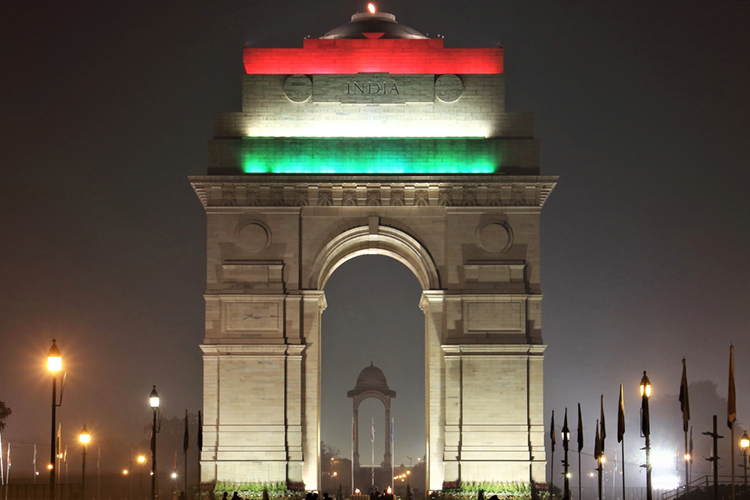Tomorrow, January 26, is Republic Day, a national holiday in India. Republic Day marks the occasion when the Constitution of India became the nation’s governing document on Jan. 26, 1950. Indian Prime Minister Jawaharlal Nehru and other leaders chose January 26 to enact the constitution in honor of the day in 1930 when India had first declared its independence from the United Kingdom. The independence process was interrupted and slow, however, and India did not officially become independent until 1947, an event now marked by India’s Independence Day on August 15.
Tomorrow morning in New Delhi, the Indian capital, Prime Minister Narendra Modi will begin the Republic Day festivities by placing a floral wreath at the India Gate war memorial. A large parade follows, rich with colorful floats, flags, and marching battalions from India’s air force, army, and navy. Other cities will host Republic Day parades as well, and people throughout the nation will celebrate with private parties and family gatherings.
The United Kingdom influenced much of India’s history beginning in the 1600's. For nearly 260 years, the British East India Company controlled much of India’s commerce and influenced its government and political system. In 1858, the British government took direct control of India after rebellions against the company’s rule. Indians did not generally feel content about British rule in India, however. Indians were discriminated against in their own homeland, where they were not allowed to advance to high positions in government service or to become officers in the army.

During World War I (1914-1918), more than 1 million Indian troops fought under British command in Africa, Europe and the Middle East. After the war, promised social and political reforms were slow in coming, and violent protests erupted in many Indian cities. By 1920, Mohandas K. Gandhi had become a leader in the Indian independence movement and in the Indian National Congress, India’s most important political organization. Gandhi persuaded the Congress to adopt his program of nonviolent disobedience.
On Jan. 26, 1930, members of the Indian National Congress officially declared Purna Swaraj, (complete self-rule), a declaration of independence from British authority. The declaration was nonbinding, but Indian people did gain more political and social freedoms in the 1930's. The onset of World War II (1939-1945), however, disrupted progress. The Indian National Congress refused to support the British war effort, demanding instead immediate independence. Despite this refusal, many Indian soldiers fought with the British (and some against them) during the war. The British promised that they would grant India independence after the fighting stopped.
In 1947, Indian and British leaders agreed to divide the country into Hindu-dominated India and Muslim-dominated Pakistan. The leaders saw no other way of ending violence between Hindus and Muslims, which had taken place for many years and hindered the independence process. India became an independent nation on Aug. 15, 1947. Pakistan had become an independent nation the day before. The two new nations then fought a bloody war for control of the contested border area of Kashmir.
Jawaharlal Nehru, a close associate of Gandhi, became India’s first prime minister after independence. A constituent assembly drew up a new constitution. The assembly approved the constitution in November 1949. It went into effect on Jan. 26, 1950.
Untitled Document
Can't view the linked articles? Subscribe to World Book Online

World Book Online delivers a progressive sequence of core databases supported by supplemental
tools, such as language translation, graphic organizers, and unique Webquests. Moving from
Early World of Learning to World Book Advanced, World Book Online aligns end-users with their
appropriate learning levels. Each stand-alone site provides additional features to support the
needs of users’ specific capabilities.
The World Book Difference
World Book combines cutting-edge technology with traditional editorial excellence to produce
authoritative, trustworthy, and unbiased content. The digital content is updated in real time and
carefully curated for each learning level. Accessible 24/7, the content is available on a variety of devices.
World Book Online combines 21st-century instructional techniques with timely information.
By breaking down complex topics and using easily understandable text, World Book Online helps to
build fluency and increase comprehension. Featuring single sign-on capability, these sites are paired
with highly visual content to engage even the most reluctant reader. Our collection of resources kindles
a lifelong learning experience for every user. This adherence to clarity, currency, and accuracy makes
World Book’s digital offerings an information hub for the classroom, library, and beyond.
Image 1: Soldiers parade on camelback during the Republic Day Parade in New Delhi, India. Credit: Lawrence Jackson, White House
Image 2: New Delhi’s India Gate is a war memorial originally dedicated to the more than 74,000 Indian soldiers killed during World War I (1914-1918). Credit: © Rakesh Nayar, Shutterstock